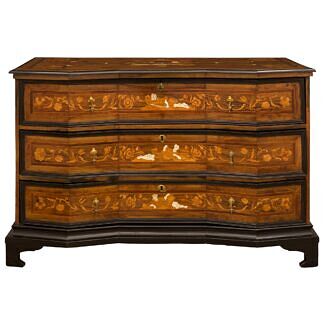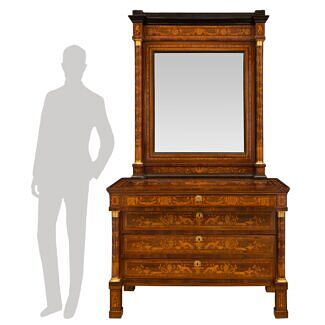-
×
 An Italian mid 18th century Walnut, Ebony, bone, and bronze commode from the Lombardi region Item # 6949
1 × Your Price
An Italian mid 18th century Walnut, Ebony, bone, and bronze commode from the Lombardi region Item # 6949
1 × Your Price
Subtotal: $74,500.00
 An Italian mid 18th century Walnut, Ebony, bone, and bronze commode from the Lombardi region Item # 6949
An Italian mid 18th century Walnut, Ebony, bone, and bronze commode from the Lombardi region Item # 6949
Subtotal: $74,500.00








List: $58,500.00
An exquisite and extremely decorative Italian early 19th century Neo-Classical st. ormolu, Fruitwood, and ebonized Fruitwood inlaid chest and original matching mirror. The four drawer chest in the manner of Giuseppe Maggiolini is raised by elegant square legs with fine... — Read More
An exquisite and extremely decorative Italian early 19th century Neo-Classical st. ormolu, Fruitwood, and ebonized Fruitwood inlaid chest and original matching mirror. The four drawer chest in the manner of Giuseppe Maggiolini is raised by elegant square legs with fine mottled feet and decorated with lovely foliate inlays. At the center are three drawers each displaying a stunning and wonderfully executed array of intricately inlaid scrolled foliate designs of amphora, vessels, musical instruments, staffs, and roaring lions with ormolu keyhole escutcheons and flanked by striking columns with elegant ormolu top and bottom caps. The top drawer also displays a fine richly chased ormolu keyhole escutcheon with a tied berried laurel design set on additional stunning inlaid designs of charming cherubs holding swaging blooming flower garlands and outstanding reserves of finely detailed portraits. The top of the chest displays spectacular inlaid designs with a central reserve of a young faun pulling a tied centaur with a boy on his back amidst additional impressive tied swaging floral garlands with playful cherubs hanging from vines. At each side are finely detailed portraits framed within a fine floral wreath with lovely pyrogravure detail all framed in elegant and most decorative fillets and floral bands at the border. The original matching mirror above retains its original mirror plate set framed within a fine mottled border with additional fine fillets, floral designs, and flanked by impressive architectural columns at each side. The columns each display mottled ormolu top and bottom caps and inlaid wrap around vines with grapes leading upwards. Above each column are charming musical instruments flanking a band with additional finely detailed portraits and cherubs holding swaging floral garlands all below the mottled ebonized fruitwood top crown. — Read Less
H: 84.5 in L: 47.25 in D: 23.75 in
H: 215 cm L: 120 cm D: 60 cm
# 6733 - H: 37" L: 56" D: 26"
# 6433 - H: 43" L: 55" D: 22"
# 6949 - H: 37" L: 57" D: 26"

